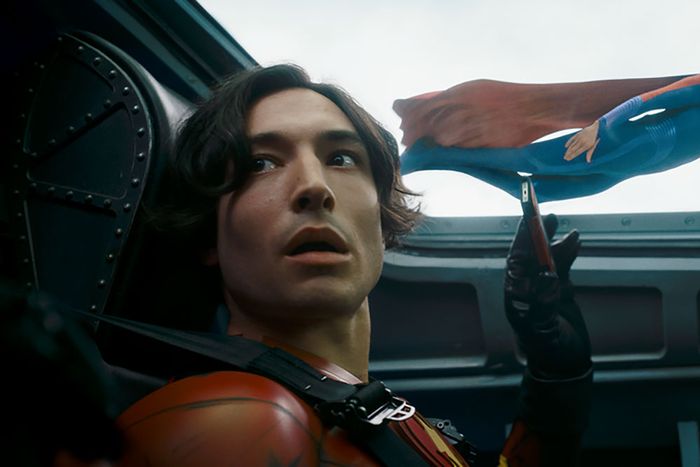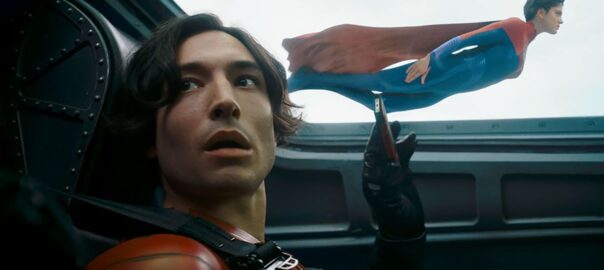[ad_1]

This piece was originally published in June. We are recirculating it now timed to The Flash’s streaming debut on HBO Max. Warning: many spoilers ahead!
One of the major selling points of The Flash is the return of Michael Keaton, who last played the Caped Crusader in Batman Returns more than 30 years ago. Of course, Ben Affleck has been the Dark Knight in the current DC cinematic universe since 2016, and he does appear early on in The Flash for an action scene and to deliver some words of advice. But once Barry Allen (Ezra Miller) travels back in time to rewrite the most painful event of his past, the existing continuity radically changes, allowing for a number of uncanny but familiar cameos: figures from have-been and could-have-been comic-book universes — including Adam West’s Batman, Helen Slater’s Supergirl, and at least three different Supermen. By movie’s end, the preexisting DC continuity is restored and these figures fade back into multiverse hypotheticals … with one startling exception: George Clooney’s Batman is back, baby.
Before the cut to credits, Barry gets on the phone with Bruce Wayne, who’s about to meet him outside of the courthouse where his father has just been rightfully acquitted of his mother’s murder (long story). But instead of Affleck stepping out of Bruce’s fancy car, out pops Clooney, who played Batman in 1997’s much maligned Batman & Robin.
Hold on. Didn’t Batman & Robin take place in the same universe as the Tim Burton films? Wouldn’t that make Clooney’s version the same Bruce Wayne as Keaton’s? Well, yes and no. Thanks to Barry’s time-travel meddling, Affleck’s grizzled Batman appears to have been erased from existence, possibly for good. In his place, we now have Clooney’s suave version of the character — one who appears to be familiar with Barry despite Barry’s shock to see him.
To get technical, the Val Kilmer–fronted Batman Forever (1995) and its sequel, Batman & Robin, are indeed both sequels to the Burton films — given their numerous callbacks to the events of Batman (1989) and Batman Returns (1992) as well as the presence of actors like Michael Gough as Alfred and Pat Hingle as Commissioner Gordon across all four movies. This wasn’t all that weird at the time. Historically, audiences have been generally accepting of recasting and breaks in continuity. (They still are — outside of hard-core fandoms.) Joel Schumacher’s Gotham was a neon-drenched, red-light-district version of Burton’s elegant, gothic conception, and yet both were supposed to be the same city. Likewise, as with most Bond movies until the Daniel Craig era, it didn’t really matter what happened in what specific order. Enough common elements and side characters carried over that audiences could accept these stories as more or less stand-alone, episodic films with a loose and mutable continuity.
In the last 15 or so years, however, Marvel has altered the norm for cinematic universes, training audiences to expect seamless continuity across all of its properties. The CW’s superhero shows (The Flash, Supergirl, Arrow, and so on) followed suit, treating live-action DC properties, past and present alike, as unique but interrelated universes. John Wesley Shipp — who already plays two other major characters on the CW’s Flash show — reprised his role as Barry Allen from the 1990 Flash series. The CW’s multiverse event Crisis on Infinite Earths (named for the continuity-collapsing comics saga) likewise reintroduced older actors like Burt Ward, the Robin of the 1960s Batman show, and Robert Wuhl as reporter Alexander Knox from Burton’s 1989 film. Even Miller cameoed alongside Grant Gustin’s TV version of the Scarlet Speedster, in effect placing the new Flash movie within the Flash TV show’s enormous multiverse.
[Deep breath] The film therefore has ties to every DC property that came before it, making the idea of two different Batman actors showing up as ostensibly different characters surprisingly easy to swallow. Plus it’s an excuse to pack in that sweet, sweet pop of nostalgia. But will we see Clooney back full time as the new (old-new? new-old?) Batman under the stewardship of new DC boss James Gunn?
The Flash helmer Andy Muschietti was just confirmed as director of an upcoming Batman film titled The Brave and the Bold, though there’s no official word on who’ll play the Caped Crusader in that film. Like with many of The Flash’s cameos, Clooney’s charming appearance (in a role he’s on record as having despised!) speaks to how audaciously these parts can now be rewritten and recast, often drawing from past films that weren’t well-liked at the time of their release. (See also: Andrew Garfield’s warmly received appearance as Peter Parker in Spider-Man: No Way Home.)
The film’s conclusion doesn’t hint at other aspects of this world that may have changed, but a comedic post-credits appearance from Jason Momoa’s Aquaman — in which he falls asleep face-first in a puddle after binge drinking with Barry — all but ensures that we’re still in the continuing DC Universe, given Momoa’s upcoming appearance in Aquaman and the Lost Kingdom. But this otherwise open ending feels like Gunn hedging his bets ahead of any major reboots. With all of the multiverse loopholes this movie opens up, there’s nothing stopping existing characters like Gal Gadot’s Wonder Woman or Margot Robbie’s Harley Quinn from appearing alongside newly recast versions of Batman, Superman, and the like.
We do know that Affleck has been, at least temporarily, erased from the current continuity, providing a soft farewell to the existing incarnation of the DC Extended Universe. It’s been a wild ride for Batfleck, from his DIY CrossFit regimen in Batman v Superman: Dawn of Justice to his attempts at smiling in Justice League. But until Gunn lights up the Dunkin’ signal, that’s a wrap.
See All
[ad_2]
Source link
